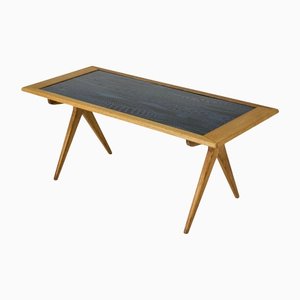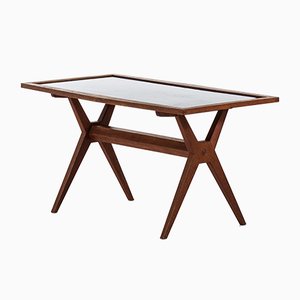
Swedish designer, ceramist, illustrator, and painter Stig Lindberg (1916-1982) was one of his country’s most prominent creatives from the late-1930s through the 1970s, a time often considered to be the “golden age” of Scandinavian design. He graduated from Stockholm’s University College of Art, Crafts & Design (now known as Konstfack) in 1937. Shortly after, he joined Gustavsberg ceramics manufactory, located just outside Stockholm, as a faience painter under the tutelage of then creative director, Wilhelm Kåge. These two masters of applied arts worked closely together, until Kåge retired and Lindberg succeeded him in 1949. During the 1950s and ‘60s, Lindberg was highly prolific for Gustavsberg, and his signature collections in stoneware, faience, and porcelain—including Pungo (1953), Spisa Ribb (1955), Domino (1955), Terma (1955), and Berså (1960-74)—were among the company’s most popular.
As a jack-of-all-trades, Lindberg was interested in various design fields, including industrial design, textile design, painting, and glassblowing. In 1947, he began collaborating with Astrid Sampe, head textile designer at the NK Department Store in Stockholm. The pair designed playful and surrealist textile prints that have become icons of the Swedish modern movement, including Melodi (1947), Friktlåda (1947), Pottery (1947), and Lustgården (1954).
In 1957, Lindberg began a professorship in ceramics at his alma mater, where he mentored famous glass artists, Bertil and Ulrica Hydman-Vallien. In 1959, he designed the Lumavision LT 104 swivel-screen television, followed by a transistor radio in 1962, both for Luma. He is also known for his whimsical illustrations for a series of children’s books authored by Lennart Hellsing.
Lindberg worked with Gustavsberg until 1980, and many of his services, , , and other are still in production today. With an approach imbued with humor and originality, Lindberg is considered one of Sweden’s most important designers from the postwar era. He was the recipient of numerous awards in his lifetime, such as Triennale de Milano Grand Prix in 1951 and 1954. His collections can be found in museums worldwide, including the Nationalmuseum in Stockholm and the Röhsska Museum in Gothenburg.
Lindberg passed away in 1982.


